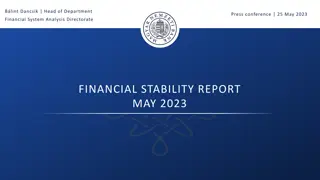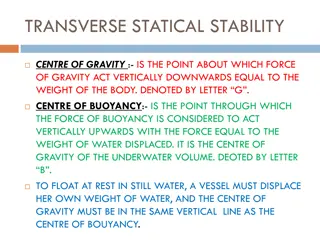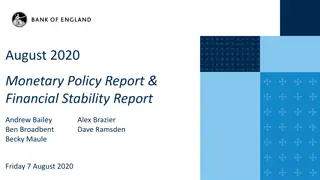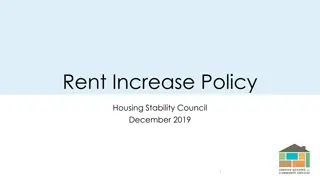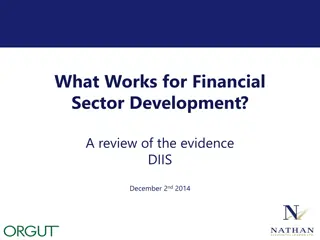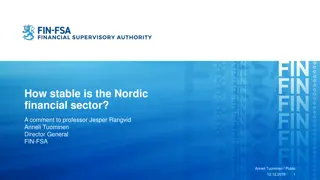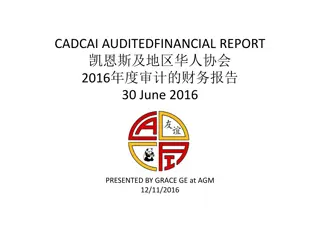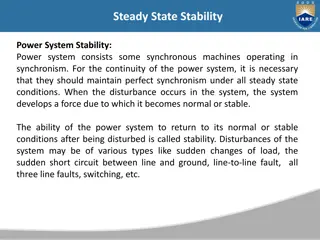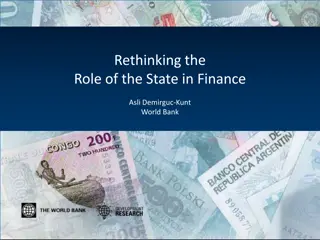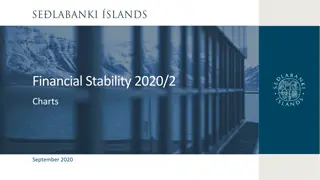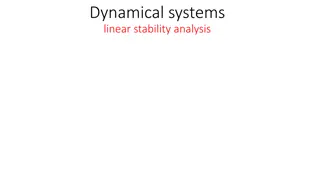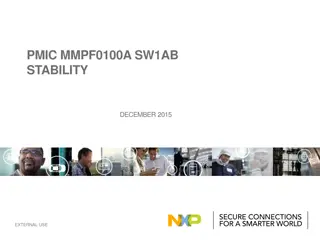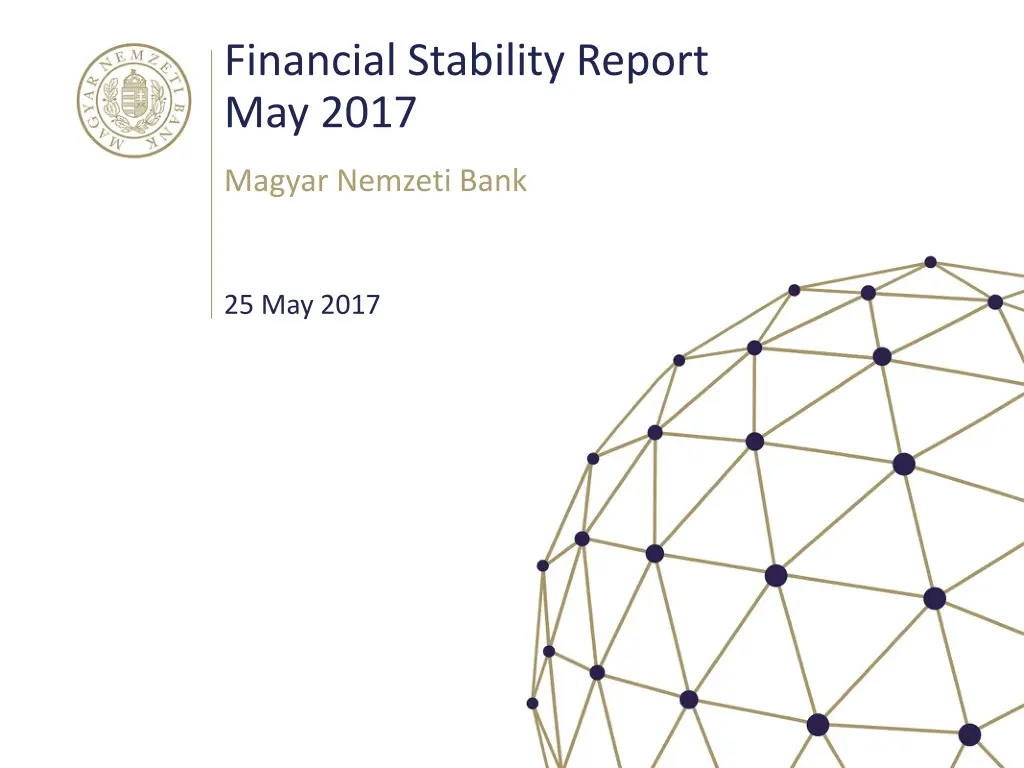
Financial Stability Report May 2017 by Magyar Nemzeti Bank
Discover the insights from the Financial Stability Report May 2017 released by Magyar Nemzeti Bank. The report covers the shock resilience of the banking sector, highlights the stability of the capital position, liquidity levels, and key vulnerabilities in the banking system. Stay informed about the current state of the banking sector for better decision-making.
Download Presentation

Please find below an Image/Link to download the presentation.
The content on the website is provided AS IS for your information and personal use only. It may not be sold, licensed, or shared on other websites without obtaining consent from the author. If you encounter any issues during the download, it is possible that the publisher has removed the file from their server.
You are allowed to download the files provided on this website for personal or commercial use, subject to the condition that they are used lawfully. All files are the property of their respective owners.
The content on the website is provided AS IS for your information and personal use only. It may not be sold, licensed, or shared on other websites without obtaining consent from the author.
E N D
Presentation Transcript
Financial Stability Report May 2017 Magyar Nemzeti Bank 25 May 2017
I. Shock resilience of the banking sector II. Highlights
The capital position of the banking sector is highly stable HUF Bn per cent 2 000 40 1 500 30 1 000 20 500 10 0 0 -500 -10 Q2 Q3 Q3 Q4 Q4 Q2 Q3 Q4 Q2 Q3 Q4 Q3 Q4 Q2 Q4 Q2 Q3 Q4 Q2 Q3 Q4 Q2 Q4 Q2 Q3 Q2 Q3 Q4 Q2 Q3 Q4 Q2 Q3 Q2 Q3 Q4 2006 Q1 2005 Q1 2007 Q1 2008 Q1 2009 Q1 2010 Q1 2011 Q1 2012 Q1 2013 Q1 2014 Q1 2015 Q1 2016 Q1 Capital need to meet regulatory requirement Capital buffer above the regulatory requirement Solvency Stress Index (RHS) Solvency Stress Index Note: The indicator is the sum of normalisedcapital shortages relative to the regulatory minimum level, weighted by the capital requirement in a common stress scenario calculated with fixed shock. The higher the value of the index, Magyar Nemzeti Bank the higher the solvency risk. Source: MNB. 3
Liquidity is sufficient even in a stress scenario HUF Bn per cent 1 400 70 1 200 60 1 000 50 800 40 600 30 400 20 200 10 0 0 -200 - 10 -400 - 20 2016 Q4 2015 Q4 2016 Q1 2016 Q2 2016 Q3 Liquidity need to meet the regulatory requirement Liquidity buffer above the regulatory requirement Liquidity Stress Index (right-hand scale) The Liquidity Stress Index Note: The indicator is the sum of the liquidity shortfalls in percentage points (but maximum 100 percentage points) compared to the 100 per cent regulatory limit of the LCR, weighted by the balance sheet total in the stress scenario. The higher the value of the indicator, the greater the liquidity risk. Source: MNB. Magyar Nemzeti Bank 4
Highlights The EMU s banking system is still vulnerable in the changing interest rate environment. There was an improvement in the domestic operating environment of banks, but developments in the real estate sector need close monitoring. Banks closed the year with outstanding profit, however, this was mainly the result of one-off, not sustainable items. Portfolio cleaning is intensive in the corporate sector, the remaining stock can be managed within a market-based framework. The non-performing household portfolio is characterized by more sales than before, but the social aspect of the problem still needs to be treated. There is a need for a more intensive price competition in household lending. Decline in spreads can be offset by increasing cost efficiency. Magyar Nemzeti Bank 5
Highlights The EU s banking system is still vulnerable in the changing interest rate environment. There was an improvement in the domestic operating environment of banks, but developments in the real estate sector need close monitoring. Banks closed the year with outstanding profit, however, this was mainly the result of one-off, not sustainable items. Portfolio cleaning is intensive in the corporate sector, the remaining stock can be managed within a market-based framework. The non-performing household portfolio is characterized by more sales than before, but the social aspect of the problem still needs to be treated. There is a need for a more intensive price competition in household lending. Decline in spreads can be offset by increasing cost efficiency. Magyar Nemzeti Bank 6
With an improving outlook, expectations lead to divergent developments in capital markets point point 2 400 170 US election 2 300 165 2 200 160 2 100 155 2 000 150 1 900 145 1 800 140 Jul-16 May-16 May-17 Mar-16 Apr-16 Oct-16 Mar-17 Apr-17 Sep-16 Nov-16 Jan-17 Dec-16 Jun-16 Aug-16 Feb-17 S&P 500 benchmark index 10 Year US Treasury Bond (RHS) Changes in the S&P 500 composite index and the 10-year US bond index following the US elections Source: Datastream. Magyar Nemzeti Bank 7
Eurozone lending activity has remained weak per cent per cent 20 20 15 15 10 10 5 5 0 0 -5 -5 -10 -10 -15 -15 Non-financial Corporations Households -20 -20 2015 2014 2011 2012 2013 2014 2016 2011 2012 2013 2015 2016 Eurozone average Annual growth rate of the private sector s outstanding loans in the euro area Source: EKB. Magyar Nemzeti Bank 8
The persistently low profitability affects recapitalization efforts in a negative way % 20 15 ROE five year average (2012-2016) 10 CE 5 MB BPSO BFE BDB ISP BPE 0 UBI -5 UCG CVAL -10 Italian banks -15 -20 0,0 0,5 1,0 1,5 2,0 PTBV ratio (2016) The relationship of European listed bank's price to book value and five year average of ROE ratio Source: Datastream. Magyar Nemzeti Bank 9
In Europe increasing risks are priced in, in parallel with an increase in perceived political uncertainty per cent EUR 500 75 400 60 300 45 200 30 100 15 0 0 Feb Feb Feb Feb Feb Feb Feb Feb Feb Feb May - 10 May - 14 May - 07 May - 08 May - 09 May - 11 May - 12 May - 13 May - 15 May - 16 May - 17 Nov Nov Nov Nov Nov Nov Nov Nov Nov Nov Aug Aug Aug Aug Aug Aug Aug Aug Aug Aug VSTOXX difference of 1M and 24M (RHS) European Policy Uncertainty Index VSTOXX 1-month volatility (rhs) VSTOXX 24-month volatility (rhs) Changes in volatility indices and the European political uncertainty index Source: PolicyUncertainty.com, Reuters. Magyar Nemzeti Bank 10
Highlights The EU s banking system is still vulnerable in the changing interest rate environment. There was an improvement in the domestic operating environment of banks, but developments in the real estate sector need close monitoring. Banks closed the year with outstanding profit, however, this was mainly the result of one-off, not sustainable items. Portfolio cleaning is intensive in the corporate sector, the remaining stock can be managed within a market-based framework. The non-performing household portfolio is characterized by more sales than before, but the social aspect of the problem still needs to be treated. There is a need for a more intensive price competition in household lending. Decline in spreads can be offset by increasing cost efficiency. Magyar Nemzeti Bank 11
Corporate lending expanded dynamically in 2016 per cent per cent 14 14 12 12 10 10 8 8 6 6 4 4 2 2 0 0 -2 -2 -4 -4 -6 -6 -8 -8 -10 -10 Q3 Q3 Q3 Q2 Q4 Q2 Q3 Q4 Q2 Q3 Q4 Q2 Q4 Q2 Q3 Q4 Q2 Q3 Q4 Q2 Q4 2012 Q1 2015 Q1 2010 Q1 2011 Q1 2013 Q1 2014 Q1 2016 Q1 SME sector with self-employed (MFI, Year-on-year) Corporate sector (FIS, Year-on-year) SME sector (MFI, Year-on-year) Growth rate of loans to the whole corporate sector and the SME sector Source: MNB. Magyar Nemzeti Bank 12
FGS: nearly 40,000 enterprises obtained financing with favourable conditions 0 5 10 15 20 25 % Agriculture 4 12 3 Manufacturing 5 10 3 Building and construction 1 3 1 Trade, repair 7 12 2 Transport and storage 1 3 2 Real estate activities 6 4 4 Professional, scientific and tech. activities 1 2 1 Other sectors 4 6 2 % 0 5 10 15 20 25 First Phase Second Phase Third Phase Sectoral distribution of the FGS loans Source: MNB. Magyar Nemzeti Bank 13
The FGS may be phased out in parallel with a steady expansion in lending per cent per cent 14 14 12 12 10 10 8 8 6 6 4 4 2 2 0 0 -2 -2 -4 -4 -6 -6 -8 -8 -10 -10 Q2 Q3 Q2 Q3 Q4 Q2 Q2 Q3 Q4 Q4 Q2 Q3 Q4 Q3 Q4 Q2 Q3 Q4 Q2 Q3 Q4 Q2 Q3 Q4 Q3 Q4 Q2 Q3 Q2 Q4 2010 Q1 2012 Q1 2013 Q1 2014 Q1 2015 Q1 2016 Q1 2017 Q1 2019 Q1 2020 Q1 2011 Q1 2018 Q1 Actual - SME Actual - SME incl. self-employed Forecast - SME incl. self-employed Forecast - SME Forecast for SMEs (corporate sector including self-employed) Source: MNB. Magyar Nemzeti Bank 14
With dynamic expansion the credit gap may close on the forecast horizon per cent percentage point 50 25 40 20 30 15 20 10 6-8 % y-o-y 10 5 4-6 % y-o-y 0 0 4 % y-o-y -10 -5 2002 2003 2004 2005 2006 2007 2008 2009 2010 2011 2012 2013 2014 2015 2016 2017 2018 2019 2020 Long-term trend Corporate credit-to-GDP Structural gap (RHS) Corporate sector credit-to-GDP and the structural credit gap Source: MNB. Magyar Nemzeti Bank 15
The volume of new lending to households increased further in 2016 HUF Bn HUF Bn 500 500 450 450 400 400 350 350 300 300 250 250 200 200 150 150 100 100 50 50 0 0 Q2 Q3 Q4 Q2 Q3 Q4 Q2 Q4 Q2 Q3 Q2 Q3 Q4 Q2 Q3 Q4 Q3 Q4 Q2 Q3 Q4 Q2 Q3 Q4 Q2 Q3 Q4 2012 Q1 2008 Q1 2009 Q1 2010 Q1 2011 Q1 2013 Q1 2014 Q1 2015 Q1 2016 Q1 2017 Q1 Housing loans Other consumer loans Sole proprietors - FGS Average volume 2002-2008 Home equity loans Loan refinancing 4 quarter average New household loans in the entire credit institution sector Source: MNB. Magyar Nemzeti Bank 16
We expect a sustained turnaround in household lending per cent per cent 4 4 2 2 0 0 -2 -2 -4 -4 -6 -6 -8 -8 -10 -10 -12 -12 -14 -14 -16 -16 Q2 Q4 Q3 Q4 Q2 Q2 Q3 Q4 Q3 Q4 Q2 Q3 Q2 Q3 Q4 Q2 Q3 Q4 Q2 Q4 Q2 Q3 Q2 Q3 Q4 Q3 Q4 2011 Q1 2015 Q1 2012 Q1 2013 Q1 2014 Q1 2016 Q1 2017 Q1 2018 Q1 2019 Q1 2020 Q1 Actual Forecast - Nov 2016 Forecast - May 2017 Household lending forecast Source: MNB. Magyar Nemzeti Bank 17
Household indebtedness may remain on a convergence path even with more dynamic lending percentage point per cent Corporate loan to 50 25 40 20 30 15 20 10 10 5 8-12 % y-o-y 0 0 5-7 % y-o-y -10 -5 -20 -10 1-2,5 % y-o-y -30 -15 2002 2003 2004 2005 2006 2007 2008 2009 2010 2011 2012 2013 2014 2015 2016 2017 2018 2019 2020 Long-term trend Household credit-to-GDP Structural gap (RHS) Household sector credit-to-GDP and the structural credit gap Source: MNB. Magyar Nemzeti Bank 18
The commercial real estate market has been picked up not only in Europe, but in Hungary as well HUF Bn HUF Bn 400 400 Expected start and finish of the projects 350 350 300 300 250 250 200 200 150 150 100 100 50 50 0 0 2012 H2 2014 H2 2016 H2 2018 H2 2012 H1 2013 H1 2013 H2 2014 H1 2015 H1 2015 H2 2016 H1 2017 H1 2017 H2 2018 H1 2019 H1 2019 H2 (Expected) Start of new projects (Expected) Finish of new projects Volume of newly built commercial real estate projects Source: MNB, ibuild.info. Magyar Nemzeti Bank 19
The housing market is characterized by increasing, although geographically concentrated demand per cent per cent 150 150 140 140 130 130 120 120 110 110 100 100 90 90 80 80 70 70 60 60 Q3 Q3 Q3 Q3 Q3 Q3 Q3 Q3 Q3 Q3 Q3 Q3 Q3 Q3 Q3 Q3 2002 Q1 2004 Q1 2001 Q1 2003 Q1 2005 Q1 2006 Q1 2007 Q1 2008 Q1 2009 Q1 2010 Q1 2011 Q1 2012 Q1 2013 Q1 2014 Q1 2015 Q1 2016 Q1 Budapest Municipalities Cities Real MNB housing price index broken down by settlement type (average of 2010 = 100%) Source: MNB. Magyar Nemzeti Bank 20
Housing prices are below the level justified by macroeconomic fundamentals per cent per cent 30 30 20 20 10 10 0 0 -10 -10 -20 -20 -30 -30 Q3 Q3 Q3 Q3 Q3 Q3 Q3 Q3 Q3 Q3 Q3 Q3 Q3 Q3 Q3 Q3 2003 Q1 2009 Q1 2015 Q1 2001 Q1 2002 Q1 2004 Q1 2005 Q1 2006 Q1 2007 Q1 2008 Q1 2010 Q1 2011 Q1 2012 Q1 2013 Q1 2014 Q1 2016 Q1 Uncertainty of estimates Average of estimates Deviation of housing prices from the estimated equilibrium level Magyar Nemzeti Bank 21 Source: MNB.
Housing prices in the capital slightly exceed the estimated equilibrium level per cent per cent 30 30 20 20 10 10 0 0 -10 -10 -20 -20 -30 -30 Q3 Q3 Q3 Q3 Q3 Q3 Q3 Q3 Q3 Q3 Q3 Q3 Q3 Q3 Q3 Q3 2001 Q1 2002 Q1 2003 Q1 2004 Q1 2005 Q1 2006 Q1 2007 Q1 2008 Q1 2009 Q1 2010 Q1 2011 Q1 2012 Q1 2013 Q1 2014 Q1 2015 Q1 2016 Q1 Estimated deviation from the equillibrium Uncertainty of the estimation Estimated deviation from the equilibrium house prices in Budapest Source: MNB. Magyar Nemzeti Bank 22
Highlights The EU s banking system is still vulnerable in the changing interest rate environment. There was an improvement in the domestic operating environment of banks, but developments in the real estate sector need close monitoring. Banks closed the year with outstanding profit, however, this was mainly the result of one-off, not sustainable items. Portfolio cleaning is intensive in the corporate sector, the remaining stock can be managed within a market-based framework. The non-performing household portfolio is characterized by more sales than before, but the social aspect of the problem still needs to be treated. There is a need for a more intensive price competition in household lending. Decline in spreads can be offset by increasing cost efficiency. Magyar Nemzeti Bank 23
Profit of credit institutions reached high level in 2016 even in a historical comparison per cent per cent 60 60 40 40 20 20 0 0 -20 -20 -40 -40 Credit institution sector -60 -60 2005 2007 2008 2009 2011 2012 2013 2015 2016 2006 2010 2014 2017 Q1 Domestic banks distribution based on 12-month rolling return on equity Note: based on 11 banks pre-taxationdata. Rectangles indicate the ranges between the 25th and 75th percentile, while the lines indicate the ranges between minimum and maximum level. Source: MNB. Magyar Nemzeti Bank 24
The improvement in profitability is mostly the result of one-off items -100 0 100 200 300 400 500 HUF Bn Income - 2016 446 Bank levy 71 Other 90 Provisioning 149 Costs 12 Dividends 26 Financial operations 81 Fee income 2 Interest income 44 Income - 2015 -33 HUF Bn - 100 0 100 200 300 400 500 Difference and components of the 2015 and 2016 profit after tax of the credit institutions Source: MNB. Magyar Nemzeti Bank 25
After adjusting for one-off and volatile profit items, the pre-tax ROE may be 4 7 per cent ROE before taxation (Dec 2016) 17% Provisioning correction 9% One-off items Sale of VISA shares 1% Dividend income 3% Volatile profit items Trading income 1% Bank levy 2% 4% 7% "Core" ROE 0 5 10 15 20 per cent Profitability as a proportion of equity, one-off effects and volatily components Source: MNB. Magyar Nemzeti Bank 26
Highlights The EU s banking system is still vulnerable in the changing interest rate environment. There was an improvement in the domestic operating environment of banks, but developments in the real estate sector need close monitoring. Banks closed the year with outstanding profit, however, this was mainly the result of one-off, not sustainable items. Portfolio cleaning is intensive in the corporate sector, the remaining stock can be managed within a market-based framework. The non-performing household portfolio is characterized by more sales than before, but the social aspect of the problem still needs to be treated. There is a need for a more intensive price competition in household lending. Decline in spreads can be offset by increasing cost efficiency. Magyar Nemzeti Bank 27
Cleaning of the non-performing corporate loan portfolio continues further per cent HUF Bn 25,0 1 500 22,5 1 350 20,0 1 200 17,5 1 050 15,0 900 12,5 750 10,0 600 7,5 450 5,0 300 2,5 150 0,0 0 IV. IV. IV. IV. IV. IV. IV. IV. IV. IV. IV. IV. IV. IV. IV. IV. 2011.II. 2001.II. 2002.II. 2003.II. 2004.II. Non performing loans without 90+ days delinquency Loans with 90+ days delinquency (RHS) 31-90 days delinquency ratio 90+ days delinquency ratio Ratio of non performing loans 2005.II. 2006.II. 2007.II. 2008.II. 2009.II. 2010.II. 2012.II. 2013.II. 2014.II. 2015.II. 2016.II. Share of non-performing corporate loans of the credit institution sector Source: MNB. Magyar Nemzeti Bank 28
Despite the portfolio cleaning project loans still pose a risk HUF Bn HUF Bn 1 600 1 600 1 500 1 500 1 400 1 400 1 300 1 300 24% 22% 1 200 1 200 23% 1 100 1 100 1 000 1 000 29% Highlighted topic: Introduction of the Systemic risk buffer (SRB) 900 900 30% 27% 30% 30% 800 800 33% 700 700 30% 23% 33% 25% 600 600 17% 18% 18% 17% 18% 500 500 14% 21% 400 400 20% 20% 21% 25% 300 300 29% 30% 200 200 30% 27% 28% 29% 31% 28% 100 100 0 0 2015Q1 Market value of CRE served as coll. for past project loans put into balance sheet Non-performing loans in less than 90 days delinquency - project loans Non-performing loans in more than 90 days delinquency - project loans Non-performing loans in less than 90 days delinquency - other loans Non-performing loans in more than 90 days delinquency - other corporate loans Q2 Q3 Q4 2016Q1 Q2 Q3 Q4 Non-performing corporate loans by project and other categories and by delinquency Source: MNB. Magyar Nemzeti Bank 29
Highlights The EU s banking system is still vulnerable in the changing interest rate environment. There was an improvement in the domestic operating environment of banks, but developments in the real estate sector need close monitoring. Banks closed the year with outstanding profit, however, this was mainly the result of one-off, not sustainable items. Portfolio cleaning is intensive in the corporate sector, the remaining stock can be managed within a market-based framework. The non-performing household portfolio is characterized by more sales than before, but the social aspect of the problem still needs to be treated. There is a need for a more intensive price competition in household lending. Decline in spreads can be offset by increasing cost efficiency. Magyar Nemzeti Bank 30
Cleaning of the household portfolio started, but the unsolved stock is still high HUF Bn per cent 700 35 600 30 500 25 400 20 300 15 200 10 100 5 0 0 2012Q4 2013Q4 2014Q4 2015Q4 2016Q4 2012Q4 2013Q4 2014Q4 2015Q4 2016Q4 2012Q4 2013Q4 2014Q4 2015Q4 2016Q4 2012Q4 2013Q4 2014Q4 2015Q4 2016Q4 2012Q4 2013Q4 2014Q4 2015Q4 2016Q4 2012Q4 2013Q4 2014Q4 2015Q4 2016Q4 Housing loan Housing loan subsidised Home equity loan Personal and hire purchase loan Loan for car purchase Overdraft and credit card Stock NPL ratio (right-hand scale) Ratio and volume of household loans overdue for more than 90 days by product Source: MNB. Magyar Nemzeti Bank 31
Number of arrangements being in line with MNB recommendation is still low, solutions based on burden sharing needed pcs pcs 80 000 80 000 70 000 70 000 60 000 60 000 50 000 50 000 40 000 40 000 30 000 30 000 20 000 20 000 10 000 10 000 0 0 May 2016 June 2016 July 2016 Number of contacts Number of non-cooperative cases Number of arrangements Aug 2016 Sept 2016 Oct 2016 Nov 2016 Dec 2016 Performance indicators of solution-seeking procedure according to MNB recommendation Source: MNB. Magyar Nemzeti Bank 32
Voluntary asset sale is the most favorable solution for both the debtors and the lenders pcs per cent 10 000 100 8 000 90 6 000 80 4 000 70 2 000 60 0 50 2014 2013 2014 2015 2016 2013 2015 2016 2013 2014 2015 2016 Voluntary asset sale Foreclosure NAMA Number of collaterals sold Sale price per collateral value (RHS) Share of lenders from sale price (RHS) Number of collateral realizations in the banking sector and average return Source: MNB. Magyar Nemzeti Bank 33
Installments are going to increase in the case of debtors participating the exchange rate cap scheme The difference was shared by the state, the bank and the debtor The difference is recorded by the bank and paid by the debtor later HUF HUF 90 000 90 000 80 000 80 000 70 000 70 000 Installments increase after five years (by HUF ~6 thousand at a typical debtor) 60 000 60 000 50 000 50 000 40 000 40 000 30 000 30 000 Jun-08 Jun-10 Jun-11 Jun-12 Jun-13 Jun-15 Jun-16 Jun-17 Jun-18 Jun-07 Jun-09 Jun-14 Jun-19 Dec-07 Dec-08 Dec-10 Dec-12 Dec-13 Dec-14 Dec-15 Dec-17 Dec-19 Dec-09 Dec-11 Dec-16 Dec-18 Difference - before the settlement Difference - after the settlement Theoretical installment Actual sum paid by the debtor Credit history of a typical debtor in the exchange rat cap scheme theoretical and actual installments Note: the debtor represented on the figure took a CHF loan amounting HUF 6 million in June 2007, with 20 years initial maturity and an interest rate of 5 per cent. The debtor suffered a 1.8 interest rate hike. Source: MNB. 34
Installments of 69 thousand debtors will increase, in 44 thousand cases the maturity will rise as well Exchange rate cap debtor with a living contract? 120 thousand debtors HUF 828 Bn debt 69 thousand debtors ~ HUF 496 Bn debt Increasing installment? 44 thousand debtors ~ HUF 303 Bn debt Maturity lengthening? Maturity lengthening > 5 years? 5 thousand debtor ~ HUF 55 Bn debt Forr s: based on the answers of the 10 most active Hungarian retail banks. 35
Following the extension of the loan term the installments rise by 6-8 thousands HUF on average thousand contracts HUF thousand 50 16 45 14 40 12 35 10 30 25 8 20 6 15 4 10 2 5 0 0 0-5 per cent 5-10 per cent 10-15 per cent above 15 per cent Increase in installments Number of contracts Average increase in installments (right-hand scale) Distribution of the contracts based on the expected increase of the installments and average increase of the installments by categories Note: the chart show the increase of the installment following the extension of the loan term. Source: based on survey filled in by 10 banks being most active in retail. 36
Highlights The EU s banking system is still vulnerable in the changing interest rate environment. There was an improvement in the domestic operating environment of banks, but developments in the real estate sector need close monitoring. Banks closed the year with outstanding profit, however, this was mainly the result of one-off, not sustainable items. Portfolio cleaning is intensive in the corporate sector, the remaining stock can be managed within a market-based framework. The non-performing household portfolio is characterized by more sales than before, but the social aspect of the problem still needs to be treated. There is a need for a more intensive price competition in household lending. Decline in spreads can be offset by increasing cost efficiency. Magyar Nemzeti Bank 37
High operating expenses are compensated via interest income 3,5 3,5 BG HU 3,0 3,0 RO Net interest income / total assets (%) SK CZ 2,5 2,5 GR CY PL SI 2,0 2,0 EEES MT LV LT PO 1,5 1,5 BE AT IT IE NL DE DK SE 1,0 1,0 FR UK LU FI 0,5 0,5 0,0 0,0 0,0 0,5 1,0 1,5 2,0 2,5 3,0 3,5 Operating expenses / total assets (%) Net interest income and operating expenses as a proportion of total assets Source: ECB. Magyar Nemzeti Bank 38
The domestic banking sector is heterogenous: only a part of banks improve their cost efficiency per cent per cent 6 6 5 5 4 4 3 3 2 2 1 1 Weighted average Level to be achieved (EU average) 0 0 2005 2006 2007 2008 2009 2010 2011 2012 2013 2014 2015 2016 Distribution and average of banks' cost efficiency (operative expenses / total assets ratio) Note: The lines are representing minimum-maximum, while rectangles are showing the range between the 25th and 75th percentiles. Magyar Nemzeti Bank 39 Source: MNB.
High spreads are applied mainly in the case of mortgage loans with a long interest rate period 100 BE SK Share if loans with an initial rate fixation of more NL 90 Higher spreads of loans with longer interest rate fixation compared to loans with short-term fixation UK DE 80 DK 70 CZ IT 60 than one year HU 50 40 ES SE SI 30 IE RO 20 10 0 -1.5 -0.5 -1.0 0.0 1.0 1.5 0.5 Difference in spreads of loans with fixed and variable interest rate Share of housing loans with an initial interest rate fixation of more than one year and average premium of longer interest rate fixation compared to short term fixation Source: MNB. Magyar Nemzeti Bank 40
Spreads are 50 per cent higher on average in the case of loans with an interest rate fixation of over one year per cent per cent 30 100 27 90 24 80 In order to increase comparability of products and raise the level of competition MNB developed the concept of Certified consumer-friendly housing loan . 21 70 18 60 15 50 12 40 9 30 6 20 3 10 0 0 0-0.5 1-1.5 7.5-8 2-2.5 3-3.5 4-4.5 5-5.5 6-6.5 7-7.5 8-8.5 9-9.5 10- 0.5-1 1.5-2 2.5-3 3.5-4 4.5-5 5.5-6 6.5-7 8.5-9 9.5-10 Spread above BUBOR / IRS (percentage point) Initial rate fixation > 1 year Initial rate fixation < 1 year Initial rate fixation > 1 year (cumulated, right-hand scale) Initial rate fixation < 1 year (cumulated, right-hand scale) Distribution of spreads over IRS and BUBOR for variable-rate housing loans and those with interest rate fixation Magyar Nemzeti Bank 41 Source: MNB.
With a more intensive price competition banks cost efficiency and the ability to innovate may rise Higher price competition Lower spreads Lower income Accommodation of banks Improvement in efficiency Cheaper banking Sustaining profit Increasing competitiveness, increasing stability! Forr s: MNB. Magyar Nemzeti Bank 42
Highlights The EU s banking system is still vulnerable in the changing interest rate environment. There was an improvement in the domestic operating environment of banks, but developments in the real estate sector need close monitoring. Banks closed the year with outstanding profit, however, this was mainly the result of one-off, not sustainable items. Portfolio cleaning is intensive in the corporate sector, the remaining stock can be managed within a market-based framework. The non-performing household portfolio is characterized by more sales than before, but the social aspect of the problem still needs to be treated. There is a need for a more intensive price competition in household lending. Decline in spreads can be offset by increasing cost efficiency. Magyar Nemzeti Bank 43

